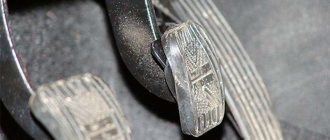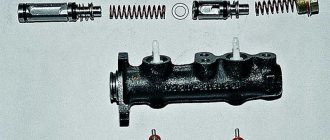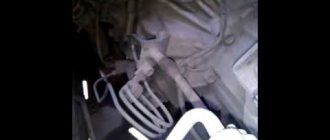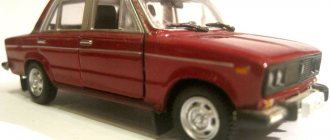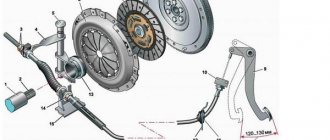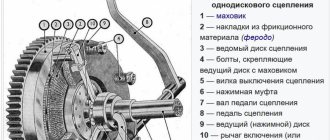The main function of the clutch hydraulic drive is to provide short-term separation of the flywheel and transmission when changing gears. If the VAZ 2107 clutch pedal is pressed very easily or immediately falls through, you should think about bleeding the hydraulic cylinder of the release bearing drive. To accurately identify the problem, it is necessary to check the level of working fluid in the master cylinder reservoir. You can repair the clutch without contacting a car service specialist.
- Design of the main elements of the hydraulic drive
Design and purpose of the clutch master cylinder - Replacing the master cylinder
- Dismantling and assembling the master cylinder
Video: replacing the clutch master cylinder VAZ 2101–07
- Video: replacing the clutch slave cylinder VAZ 2101–2107
- The clutch does not disengage completely (the clutch “drives”)
- Tools and materials
Video: bleeding the clutch VAZ 2101–07
How to bleed the clutch on a VAZ 2101-VAZ 2107?
Note! Always remember that you need to bleed the clutch together in a car, because it’s difficult to do this without the help of an outsider, but there is still a way out, so if you are going to bleed the clutch alone, then first read the entire article to at least visually understand how it’s done , and then run the video clip located at the very end of the article, and this video shows a visual process of bleeding the clutch, performed by just one person!
And it’s best to do all the work in a pit, because it’s much simpler and more convenient, but if it’s not there, then you can do the work without it, it’ll just be a little problematic!
1) At the very beginning of the operation, pour new brake fluid into the clutch reservoir, and then close the reservoir with a plug.
Note! The liquid must be filled strictly to the very top edge! (For more information on how to fill the brake fluid into the reservoir, and why you need to fill the brake fluid at all, see the article entitled: “Replacing clutch fluid on a VAZ”)
2) Next, take a small hose in your hands and put one end of it on the fitting of the working cylinder.
3) Then ask an assistant to sit in the car and press the clutch pedal about 5 times, for the last time let him leave the pedal fully depressed.
Note! Ask an assistant to press the clutch pedal sharply and at intervals of 3 seconds!
4) Meanwhile, while the assistant holds the pedal down, prepare an empty container into which you will drain the brake fluid with bubbles, and then lower the other end of the hose into this container.
5) Then loosen the fitting with a wrench and at this time brake fluid with bubbles will begin to drain into the container you are holding.
Note! As you already understood and this was already mentioned earlier, bubbles are air that should never be present in the brake fluid, otherwise the system will begin to malfunction, in general, we continue!
6) Now wait until the clutch reservoir containing the brake fluid is almost completely empty and then immediately tighten the bleeder fitting tightly, and let the assistant take his foot off the pedal.
Note! Be sure to pay attention to the words: “It will not empty almost completely,” so you don’t have to wait until all the fluid comes out of the reservoir; in no case should it fall less than 15 mm, otherwise you will be bleeding the clutch for a very long time and most likely the system it won’t even be pumped if you do this, because when the fluid is completely emptied from the tank, during this time air begins to enter the system, and therefore the clutch hydraulic drive will depressurize again, which will lead to constant pumping!
7) Now, as you already understand, when the level reaches almost to the very bottom, then stop the bleeding operation by screwing in the bleeder fitting and the assistant removing his foot from the pedal, and then again add liquid to the tank and repeat the entire bleeding operation again.
Note! Do this operation again and again until liquid begins to flow into the container without bubbles!
Additional video clip: More details about that? You can see how to bleed the hydraulic drive in the video below:
Replacement
The cost of this type of work in a car service starts from 550 rubles. But for most car enthusiasts, this operation is not so difficult to perform on their own.
- new GVC;
- brake fluid;
- set of wrenches with extension;
- syringe or rubber bulb.
- Pump out the fluid from the hydraulic drive reservoir using a syringe or rubber bulb.
- Remove the expansion tank and move it to the side so that it does not interfere with work.
- Unscrew the tube with a 13mm wrench. Move it a little.
- Loosen the clamp and disconnect the rubber hose that goes from the tank to the cylinder.
- Unscrew the two nuts with a 13mm socket wrench and an extension.
- Remove the master cylinder from the studs.
- Replace the GCS with a new one.
- Reassemble everything in reverse order.
Bleeding the clutch
The replacement has been made, but you should not hit the road without bleeding the clutch system. The process is similar to bleeding the brakes and is carried out in the following sequence:
- Brake fluid is poured into the reservoir.
- A hose is put on the master cylinder fitting, the other end is lowered into a bottle filled with liquid. This will show how air leaves the system during the pumping process.
- The operation requires an assistant. One sits in the car and presses the clutch pedal 5-6 times on command, after which he leaves it pressed. The second one opens the fitting until the release of air stops. This is done several times until all air is removed from the clutch system.
- Tighten the fitting and add fluid to the reservoir.
Conclusion
After replacing the clutch master cylinder and bleeding the entire system, you can safely hit the road without fear that the clutch will fail and the car will lose control because of it.
Bleeding the hydraulic clutch of a VAZ 2105
Air in the clutch hydraulic drive is indicated by incomplete disengagement of the clutch, as well as “softness” and “sinking” of the clutch pedal.
| Execution order |
| 1. Clean the tank and bleeder fitting from dust and dirt. |
| 2. Check the fluid level in the hydraulic drive reservoir and add fluid if necessary. |
| 3. Place a hose on the head of fitting 9 (see Fig. Working cylinder and clutch release fork) of the working cylinder and immerse its lower end in a vessel with hydraulic fluid (30–50 g). |
| 4. Unscrew fitting 9 1/2–3/4 turn, sharply press and smoothly release the pedal until the release of air bubbles from the hose stops. |
| 5. Press the pedal and tighten the fitting as far as it will go. Remove the hose and put on the fitting cap. |
| 6. If, despite prolonged pumping, air bubbles come out of the hose, check the reliability of the connections, find out if there are cracks in the tubes or leaks in the connections with the fittings. Air may enter through damaged master or slave cylinder o-rings. |
| 7. When bleeding, the fluid level in the hydraulic drive reservoir must be above the hole in the tube connecting the reservoir to the clutch master cylinder; the end of the bleeding hose must be constantly immersed in the liquid. |
Video about “Bleeding the hydraulic clutch” for VAZ 2105
Bleeding the clutch, several ways.
The checkpoint does not work. How to properly bleed the clutch of a VAZ 2101-07 classic
HOW TO BLEED THE CLUTCH QUICKLY AND WITHOUT ASSISTANT!!!
Dismantling the hydraulic drive
To perform the operation we will need:
- container for operating fluid and a large-volume syringe.
- set of wrenches and sockets;
- screwdriver and pliers.
The order of work is as follows:
- Brake fluid is pumped out from the expansion tank of the master cylinder of a VAZ 2107 car using a syringe. A rubber tube is disconnected from the drive, from which the remains are also poured into the prepared container. If liquid gets on paint surfaces, they must be wiped with a damp cloth.
- Using an open-end wrench set to “10”, unscrew the fitting of the pipeline connecting the main and working hydraulic drives.
- Using a “13” socket and an extension adapter, unscrew the nuts holding the assembly to the engine compartment panel.
- To remove the master cylinder from the studs, simply press the clutch pedal, this will move it out of place, after which you can pull it out by hand.
In what situations should you pump
Any repair of the hydraulic drive that causes its depressurization, as well as changing the working fluid, is a direct indication for pumping. But, even if the parts or fluid have not been changed, the clutch is bled when air enters, disrupting the operation of the hydraulic drive.
Signs that the circuit is airy and the clutch needs bleeding on a VAZ 2107 are:
- pedal travel is too soft;
- difficulties and crunching when shifting gears, up to the impossibility of shifting and/or moving;
- howling or vibration when holding the clutch pedal in gear.
One of the ways to diagnose incomplete disengagement of the Zhiguli clutch is to hang the rear axle (on a lift or jacks), start the engine, engage 3rd or 4th gear and hold the clutch depressed. If the wheels begin to rotate quickly even with the pedal depressed, it means that the engine is not completely disconnected from the transmission. To correct the situation, you need to either adjust the drive or bleed the VAZ 2107 clutch cylinder.
Preparation for bleeding the clutch system of a VAZ 2106
Bleeding the clutch is not particularly difficult, so you can do it yourself. To do this, you need to prepare the necessary items in advance, and also enlist the help of a friend or relative to provide assistance: this way you will be able to follow the work procedure and complete the task faster.
Clutch bleeding is carried out on an overpass or in a pit. Before the procedure, prepare:
- new brake fluid (TF)
- rubber tube
- a transparent container that must first be filled with brake fluid
- 8 mm wrench.
Necessary tool
Then you can proceed directly to the pumping process. To do this you will need:
- Open-end wrench or socket wrench 8;
- Container for draining (with a small amount of liquid);
- New fluid;
- Silicone transparent tube;
- Rags.
This is all the required equipment.
An interesting fact is that with identically used drives on different “Classic” models, the bleeding process is different, so methods for pumping a hydraulic drive on VAZ-2106 and VAZ-2107 vehicles will be described below.
What is needed to bleed the clutch of a VAZ 2107-2101
The procedure for bleeding the clutch on a VAZ 2101 in accordance with manuals for car repair and maintenance requires the presence of an assistant who will be directly in the car during repair work. However, this work can be done alone, although it will take more time. Also, in addition to having certain repair skills, the owner will need a certain set of tools:
- A simple rubber tube for bleeding air and waste fluid.
- A set of keys for dismantling the master cylinder tank and other clutch parts in case of malfunctions.
- New fluid to fill the clutch tank. As usual, ordinary brake fluid of the DOT-3 or DOT-4 standard is most often used as such a substance.
In the case of self-repair and bleeding of the VAZ 2105 clutch, the owner will have to alternately carry out work both in the engine compartment and inside the car.
How to bleed the clutch on a VAZ 2107: injector and carburetor
All Zhiguli cars use the same type of hydraulic clutch, so the type of power supply to the VAZ 2107 engine (injector or carburetor) and its model (2101, 2103, 2104, 2105, 2106) do not play a decisive role. The only nuances can be in the features of access to the drive cylinder, since the carburetor allows you to bleed the clutch on a VAZ 2107 a little faster than an injector. Below we will look at detailed instructions on what methods you can pump up and why you may not succeed.
On cars with an injection power system, a larger air filter and a fuel adsorber are used, located on the left side of the engine compartment. They leave less space to access the cylinder from above (no pit), but usually do not require removal for bleeding.
When do you need to adjust the clutch on Lada 2107?
It is recommended to check the settings regularly at every car maintenance. But there are still signs when the procedure should be started immediately, so it wouldn’t hurt any owner to know how to bleed the clutch on a VAZ 2107 on their own. Malfunctions in the operation of the coupling during operation are expressed by the following symptoms:
- Slipping – the clutch disc slips when the pedal is fully released, and is unable to transfer all the power from the internal combustion engine to the transmission.
- Drives - the disc does not move away from the flywheel when the pedal is fully depressed, which makes it difficult to change gears.
What should I check?
The clutch may engage too early or late due to the pedal not moving properly, resulting in jerking while driving. The free play of the pedal should be within 0.4-2.0 mm; if these indicators are violated, then adjustments are necessary.
If you look under the car, you can check the free play between the pusher (indicated by the red arrow) and the release fork (blue arrow). Before adjusting the clutch on a VAZ 2107, you need to pump the fork by hand; if there is no free play or exceeds 5 mm, then adjustment of the unit is necessary, because the release bearing will be subject to constant loads.
If all adjustment parameters are normal, the pedal stroke before the clutch starts engaging should be 25-35 mm. This is determined using a ruler; if the indicator does not correspond to the norm, then you will have to adjust some components of the clutch drive system.
How to bleed the clutch on a VAZ - how to understand that there is air in the hydraulic drive
The surest way is to watch the behavior of your car. If, when you press the clutch pedal, it does not fully engage, and the pedal itself moves too easily, then this is a clear sign of depressurization. The car may also start moving earlier than it should. You can easily notice the symptoms of such a “disease”; if your vehicle simply does not respond to the pedals as it should, you feel uncomfortable.
You can contact a car service, but before that it is better to try to bleed the clutch yourself, because this is not a particularly difficult task and will get you better acquainted with your car.
What is needed to bleed the clutch of a VAZ 2107-2101
The procedure for bleeding the clutch on a VAZ 2101 in accordance with manuals for car repair and maintenance requires the presence of an assistant who will be directly in the car during repair work. However, this work can be done alone, although it will take more time. Also, in addition to having certain repair skills, the owner will need a certain set of tools:
- A simple rubber tube for bleeding air and waste fluid.
- A set of keys for dismantling the master cylinder tank and other clutch parts in case of malfunctions.
- New fluid to fill the clutch tank. As usual, ordinary brake fluid of the DOT-3 or DOT-4 standard is most often used as such a substance.
In the case of self-repair and bleeding of the VAZ 2105 clutch, the owner will have to alternately carry out work both in the engine compartment and inside the car.
This procedure is necessary in several cases:
- Planned replacement. The liquid used cannot always have the same properties. Over time, it wears out, creating less pressure in the cylinder. This affects the performance of the car. To avoid such a problem, you need to change the fluid regularly.
- Poor quality of materials used. Everyone has bought a poor quality product at least once. In this case, this will affect not only the operation of the car, but also the serviceability of other parts. That is why you need to change the low quality fluid to something better.
- Clutch depressurization. As soon as some elements of the system begin to fit loosely, liquid leakage and air ingress are possible. Both are equally bad. The fluid runs out quickly and the clutch does not work well.
- Repair work. If the clutch system fails, you need to take the car to a service center or repair it yourself. In any case, the parts will lose their tightness, air will get into them, and liquid will leak out. Why this is poorly described in the previous paragraph.
Please note! In the event of a fluid leak, bleeding the clutch will only help temporarily. In order to repair clutches, you need to check the entire system for holes or cracks. The time of air entry depends only on the hole. The main thing to remember is that over time it will become larger, which means air will get in faster.
You can understand that air has entered the hydraulic system by three main signs:
- Initial stage. The pedal is easy to press, gear shifting works, but not very well.
- Middle stage. The gears are no longer switched, the pedal is easily squeezed.
- Last stage. The pedal does not return to its place and becomes stuck.
First, let's bleed the clutch on the VAZ-2106.
For ease of work, it is better to drive the car into a pit or overpass. Additionally, outside assistance will be required.
Before starting work, you need to clean the reservoir from dust, check the fluid level and add it if necessary.
The clutch bleeder located on the slave cylinder should be cleaned. Then the protective cap is removed from this fitting and the tube is put on it. The other end must be lowered into the drain container.
Before starting pumping, it is advisable to immediately check the possibility of unscrewing the fitting; often it becomes very sour in its seat, and it is quite difficult to tear it out of place.
If you manage to tear the fitting out of place, you need to tighten it back. After this, the assistant inflates the system by sharply pressing the pedal 4-5 times, after which he holds it.
The fitting is unscrewed half a turn, after which liquid with air bubbles will flow down the tube. As soon as the fluid stops flowing, the fitting must be tightened.
Afterwards, you need to repeat the process of pumping and draining the liquid several times, periodically checking the level in the tank.
It is important to ensure that liquid begins to flow through the tube without bubbles, after which the fitting is finally tightened and the cap is put on it.
On the VAZ-2107, the preparatory work is identical - the system is checked for leaks, the tank and fitting are cleaned.
It may be necessary to remove the dust shield to access the working cylinder fitting (on injection VAZ-2107 models).
Next, the tube is put on the fitting; first it must be “torn” out of place.
The bleeding process on this car is carried out as follows: the fitting is unscrewed half a turn, the assistant sharply presses the pedal, and then gradually releases it, while the fitting does not need to be tightened back.
The assistant must press the pedal sharply until liquid without air begins to flow through the tube, after which the pedal must be pressed and held, and the fitting must be tightened.
Regarding the pumping itself, it should be noted that the process itself should not be long: on a VAZ-2106 - 4-5 pumps followed by draining and 5-7 sharp presses on the pedal with a leisurely release - on a VAZ-2107.
If the process takes more steps, you need to look for where air got into the system, fix the problem, and then pump it again.
You can check the operation of the drive after bleeding while driving.
Start the car, move slowly and change gears. If there are no signs of hydraulic drive malfunction, we can assume that the pumping was done correctly.
Tuned sports clutch
In motor sports, which is a kind of testing ground for the development and implementation of innovations in vehicle components and mechanisms, an increased load is applied to the special clutch. After all, this unit is operated when rotating at an angular speed of 6-10 thousand rpm and at the maximum power values of the power unit.
At the same time, the impact on the drive pedal increases, which creates some problems in the speed of gearbox shifting. Therefore, components such as Kevlar alloy, ceramics or polymer carbon are used as friction linings for the drive type disc. Each type of such friction compounds has its own advantages and disadvantages.
Ceramics does not heat up and withstands large impacts, but it requires the creation of high clamping force and has a reduced friction force. Carbon has high resistance to the mating surface, low material density and high heat resistance. Kevlar alloy has increased wear resistance, heat resistance and at the same time has a reduced friction index.
What is needed to bleed the clutch on a VAZ
Unfortunately, you will not be able to complete the entire procedure yourself. You will need the help of at least one person to push the right pedals for you in time, nothing else is required from him.
If there is air in your hydraulic drive, then, as a rule, it has already entered the brake fluid. First you need to replace it and then bleed the clutch.
You will need a small set of tools:
- Empty containers for draining.
- New brake fluid.
- Waste cleaning cloth.
- Rubber hose.
- A wrench, for most models you will need a figure eight wrench.
Plus your assistant - and you have assembled the main set of tools for bleeding the clutch on a VAZ.
Tooling of the workplace
Don’t know how to properly bleed the clutch on a VAZ 2106 with your own hands? Fortunately, there is a way out! To do this, you just need to use a practical guide, taking into account some recommendations. Naturally, to perform this operation you will need to have the necessary set of plumbing tools, hollow clean containers, an auxiliary hose, and rags.
If it is necessary to bleed the clutch hydraulic drive after replacing the used brake fluid with a new one, then, alas, it is impossible to do without cleaning the main fluid drain fitting. Therefore, you will definitely need a special brush with a steel working surface in the form of wire.
How to properly bleed the clutch on a VAZ 2107: step-by-step instructions
Bleeding the clutch on a VAZ 2107 should be done in a pit, overpass or lift, but in this case it may be necessary to dismantle the sub-engine protection (if installed). It is also possible to bleed from above by simply placing the machine on a level surface, but this is a little more difficult. The easiest way to pump the clutch of a VAZ 2107 is with an assistant, in which case the order of work will be as follows:
Video instructions on how to bleed the clutch on a classic VAZ in several ways
- Open the hood and remove the cover from the clutch expansion tank, located on the left on the engine shield, you need to add fluid there to the maximum.
- You need to get to the clutch slave cylinder, located to the left of the gearbox bell.
- Remove the rubber cap from the bleeder fitting, put a 8mm wrench on it and put on the hose.
- Pour 100 grams of fresh DOT 3/4 fluid into a container for draining and dip the end of the hose into it (to prevent air leaks).
- Ask an assistant to pump the clutch pedal about 5 times at intervals of 1-3 seconds and leave it depressed.
- Open the fitting of the clutch slave cylinder 0.5-1 turn of the key so that liquid flows through the hose.
- Close the fitting when the liquid stops flowing.
- Check the fuel fluid level in the tank, and if it drops, add more.
- Repeat steps 5-8 until the liquid begins to flow in an even stream without bubbles.
- Tighten the fitting, wipe the parts with a rag to remove any leaks and put the rubber cap back on.
- Check the fluid level in the tank (if it’s low, add it again) and screw on the cap.
By following these simple procedures, you will bleed the clutch drive system on a classic and achieve smooth operation.
Management
Important! If you pump after changing the fluid, you first need to clean the drain fitting of the main clutch cylinder from dirt and dust.
This is done using a brush that uses steel wire instead of bristles.
Everything you need for the operation
Work on pumping the clutch on a VAZ 2106 must be carried out on an overpass or pit. You will also need the help of a partner.
The tools we need are:
- brake fluid;
- rubber hose;
- capacity;
- key to 8.
The best option for VAZ 2106 is Neva M
Algorithm of actions
- First of all, pour fresh liquid into the VAZ 2106 tank to the bottom mark of the neck.
- Now you need to slightly loosen the fitting located on the working cylinder.
- Next you need to put a hose on it.
- We lower the other end into a container (preferably transparent) in which the remaining wateriness is located.
- At this stage you will need the participation of your partner. It is necessary that he press the pedal until its movement begins to become difficult.
- Next, he must hold the pedal in this position.
- You need to loosen the fitting little by little. At this time, liquid will begin to flow through the hose.
- If you see bubbles in the outlet, this means there is air in the system.
- When moisture starts to come out, you may notice that the clutch is failing.
- Wait until it falls completely and tighten the fitting.
- At this time, your partner should start pumping again.
- Repeat this until there are no bubbles in the outlet.
- During operation, the liquid level will naturally drop. Therefore it needs to be topped up.
- Make sure that the liquid does not fall below ten millimeters from the bottom. If the level drops too low, air will return to the system and the job will have to be repeated again.
- After completing the work, you need to check the level.
- If necessary, top up to the lower neck line.
- We tighten the cap of the VAZ 2106 tank.
- Disconnect the hose.
- We tighten the fitting.
First of all, make sure that there is no grinding of gears when the pedal is fully depressed and reverse gear is engaged. If this is still heard, it means that air remains in the system and all work will have to be repeated.
This video shows how pumping occurs correctly on VAZ 2101-2107 cars.
Tips and tricks
The main advice when carrying out such work should be to use only high-quality brake fluid, since constant malfunctions in the hydraulics of the clutch pedal will entail a whole bunch of problems in the form of failure of other parts. You should also carefully monitor the level of the working substance in the tank and other elements of the system for natural wear and tear. These include, in addition to the main cylinder, various fittings and rubber tubes, which tend to dry out and have microcracks.
Symptoms and causes of malfunction
There are not so many symptoms of air in the clutch hydraulic drive - difficult gear shifting, crunching of gear teeth when shifting, especially when engaging reverse gear, weakening of the effort to depress the clutch pedal.
Often the cause of airing is a drop in the working fluid level below the minimum value; in this case, air enters the main cylinder through the fitting.
It is possible that liquid began to leak from the system due to loose connections of the pipelines, or their damage; a leak may appear from under the cylinder sealing rings due to wear.
There may even be an option when the hole in the tank lid is clogged. This hole is needed to equalize the pressure in the tank.
And if it becomes clogged inside the system, a vacuum occurs during operation, causing air to penetrate through the sealing rings.
Well, of course, after repair work related to the clutch and its drive, the system will be aired.
To restore the drive's functionality and remove air bubbles, the system should be bled.
This operation is in many ways similar to bleeding the brake system. But before starting work, the cause of airing should be identified.
Therefore, before starting work, you should carefully inspect all drive elements for leaks. If any are found, they must first be eliminated.
Also read - why the clutch pedal fails, reasons and ways to eliminate them.
Design and principle of operation of the clutch
The clutch pedal is connected to the clutch master cylinder through a rod. The same rod acts as a piston in this cylinder. There is also a working cylinder - it is installed on the clutch housing. The piston of this cylinder is connected to the release fork.
The force from the driver's foot is transmitted through fluid, so the clutch cylinders are connected to each other by a pipeline.
Fluid is supplied to the master cylinder from the reservoir. The working element is ordinary brake fluid.
It all works like this: the driver presses the clutch pedal, the rod enters the master cylinder and pushes the fluid out of it.
To prevent the liquid from flowing back into the tank, the piston closes the supply fitting from the tank.
Since the fluid is not compressed, it moves through the pipeline and begins to press on the piston in the working cylinder. This piston comes out and pushes the fork, which acts on the release bearing.
When the pedal is released, the fork spring pushes the piston back into the slave cylinder and the fluid returns to the master cylinder.
This scheme seems simple, but may not always be reliable. If air gets inside the drive system, the efficiency of the clutch will decrease.
Air bubbles in the system will be compressed when pressure arises, this will lead to the fact that the full force will not be transmitted.
Because of this, even with the pedal fully depressed, the output of the working cylinder rod will be incomplete, the fork will not fully depress the bearing - as a result, the clutch “drives”.
Before you start working, it is better to enlist the help of another person. Then it is important to carefully check the integrity of all connections and the hose on the car - there should be no leaks, cracks, etc. Under your hood there will be either an injector or a carburetor - it all depends on the modification of the VAZ-2107 model. Work should be carried out carefully following all the following steps:
- Pour brake fluid into a transparent container.
- On the body of the working cylinder you can see the clutch bleeder fitting - this procedure will be carried out with the help of it. Remove the protective cap from it and smoothly tighten the rubber tube.
- The lower end of this same tube should be lowered into a container with brake fluid and it is important to ensure that the end of the tube always remains immersed in it.
- Pour brake fluid into the reservoir (expansion tank).
- After this, the fitting must be loosened slightly. To do this, you just need to unscrew it about half a turn.
- During this, the assistant must press the clutch pedal every three seconds and keep it pressed all the way.
- If all of the above was done correctly, then liquid will flow through the tube, and you will also notice air bubbles in it.
- Continue in this manner until the air is completely released. As soon as the bubbles stop coming out, the mission can be considered successfully completed.
- At the end, the assistant must press the pedal, and at this time you must tighten the fitting thoroughly and put on the protective cap, which you removed at the very beginning of this operation.
Hydraulic drive installation
Replacing a mechanism involves purchasing it in a retail network or via the Internet. Installation work is performed in the following sequence:
- The clutch master cylinder of the VAZ 2107 is put on the studs and pushed all the way to the base.
- The nuts are screwed onto the fasteners and tightened with a wrench to “13”.
- The union nut of the pipeline laid to the working hydraulic drive is screwed into the main cylinder.
- The rubber tube is connected to a plastic connecting element and secured with a clamp.
- The expansion tank is filled with brake fluid, which enters the main and slave cylinders of the clutch through tubes. Replacing the fluid in the system is mandatory due to wear products.
Upon completion of installation of parts, it is necessary to inspect and check the tightness of the nuts. Replacing the main or working clutch drive of a VAZ 2107 car ends with bleeding the system.

